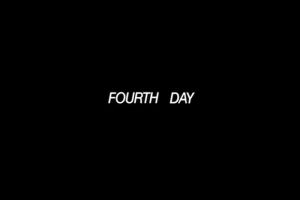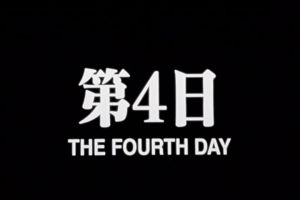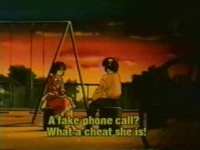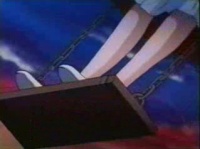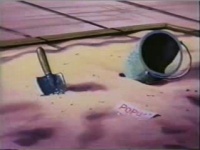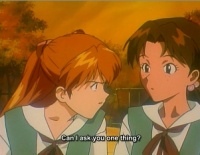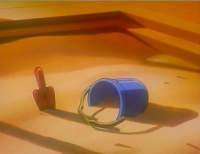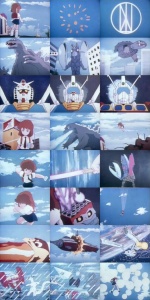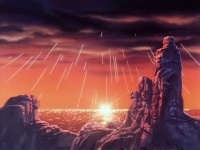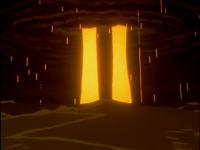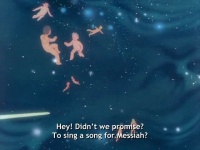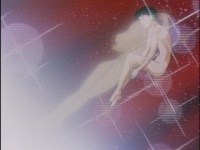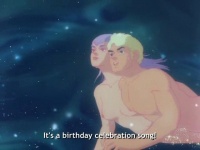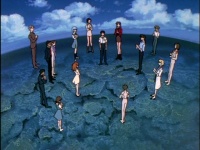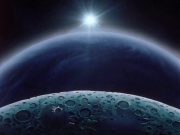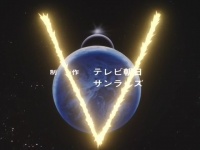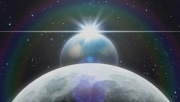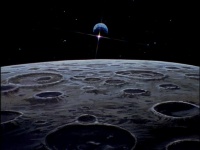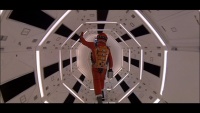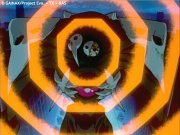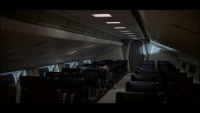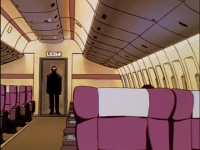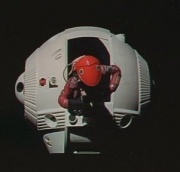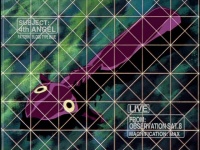Tributes to Other Fiction in Neon Genesis Evangelion: Difference between revisions
(more Totoro) |
(added superfluous moon runes) |
||
| Line 4: | Line 4: | ||
==Other anime and manga== | ==Other anime and manga== | ||
===Brother, Dear Brother (おにいさまへ...)=== | |||
In Episode 18, a scene from the Shoujo classic ''Oniisama E'' aka ''Brother Dear Brother'' is reconstructed almost shot-by-shot: | In Episode 18, a scene from the Shoujo classic ''Oniisama E'' aka ''Brother Dear Brother'' is reconstructed almost shot-by-shot: | ||
*First they establish that two close friends are chatting in a park. | *First they establish that two close friends are chatting in a park. | ||
| Line 52: | Line 33: | ||
{{-}} | {{-}} | ||
===Space Runaway Ideon=== | ===Detonator Orgun (デトネイター・オーガン)=== | ||
''Detonator Orgun'' is a three-episode OAV from 1991. While it's impossible to tell for certain whether or not it actually influenced the creators of Evangelion, there are a number of similarities that are worth noticing, even if they are entirely coincidental: | |||
The main character Tomoru synchronizes with a sentient alien bio-mecha; however, it is later revealed that the "aliens" are, in fact, not aliens at all, but super-evolved humans. The final episode features shamelessly overblown biblical symbolism, most notably in the form of Orgun's Grand Cruciform final attack. Smaller visual details include a naked girl floating in a tube, and a couple of [[Gendo Pose|Gendo Poses]]. | |||
[[Image:Detonator orgun grand cruciform.jpg|thumb|left|A cross-shaped flash when Orgun fires the Grand Cruciform]] | |||
[[Image:Detonator orgun mhiku tube.jpg|thumb|none|A pale, naked esper girl in a tube]] | |||
===My Neighbor Totoro (となりのトトロ)=== | |||
[[Image:Gunbuster ghibli references.jpg|thumb|right|Ghibli movie posters in Gunbuster.]] | |||
[[Image:Shinji-jizo-san.jpg|thumb|left|Shinji rests by a statue of Jizo-san.]] | |||
[[Image:Mei-jizo-san.jpg|thumb|none|The lost Mei rests by statues of Jizo-san.]] | |||
In Episode 04, after exiting the bus, Shinji rests by a statue of Jizo-san, the patron deity of travelers and children. This shot is apparently a tribute to a similar shot from Miyazaki's ''My Neighbor Totoro.'' Considering that Anno has worked as an animator on Miyazaki's ''Nausicaä'' and that he's made references to Ghibli films before Evangelion, this comparison doesn't seem too far-fetched. | |||
===Space Runaway Ideon (伝説巨神イデオン)=== | |||
| Line 131: | Line 132: | ||
{{-}} | {{-}} | ||
===The Super Dimension Fortress Macross=== | ===The Super Dimension Fortress Macross (超時空要塞マクロス)=== | ||
[[Image:Macross studio wrecking.jpg|thumb|right|Breaking the fourth wall?]] | [[Image:Macross studio wrecking.jpg|thumb|right|Breaking the fourth wall?]] | ||
Revision as of 17:10, 3 January 2009
As the title says, this page is for listing references or tributes to other shows found in Evangelion. See also: Tributes to Neon Genesis Evangelion in other Anime and Manga, Tributes to Neon Genesis Evangelion in other Media, Gainax: Evangelion References and Cross References, and Similarities to Neon Genesis Evangelion in other Anime and Manga.
Other anime and manga
Brother, Dear Brother (おにいさまへ...)
In Episode 18, a scene from the Shoujo classic Oniisama E aka Brother Dear Brother is reconstructed almost shot-by-shot:
- First they establish that two close friends are chatting in a park.
- Then there is a lingering shot of their feet...
- ...and then a shot of a nearby sandbox including a pail and shovel.
The cast of Oniisama E also includes characters named "Rei Asaka" aka "Hana no Saint Juste" (Saint Juste of the Flowers), and "Kaworu Orihara" aka "Kaworu no Kimi" (Prince Kaworu).
Detonator Orgun (デトネイター・オーガン)
Detonator Orgun is a three-episode OAV from 1991. While it's impossible to tell for certain whether or not it actually influenced the creators of Evangelion, there are a number of similarities that are worth noticing, even if they are entirely coincidental:
The main character Tomoru synchronizes with a sentient alien bio-mecha; however, it is later revealed that the "aliens" are, in fact, not aliens at all, but super-evolved humans. The final episode features shamelessly overblown biblical symbolism, most notably in the form of Orgun's Grand Cruciform final attack. Smaller visual details include a naked girl floating in a tube, and a couple of Gendo Poses.
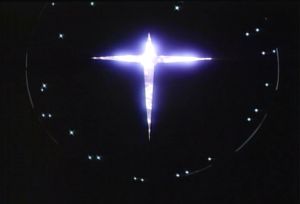
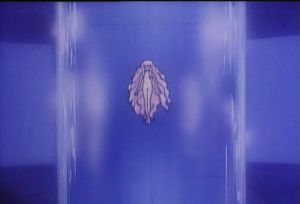
My Neighbor Totoro (となりのトトロ)
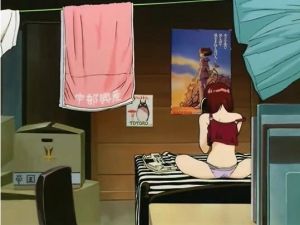
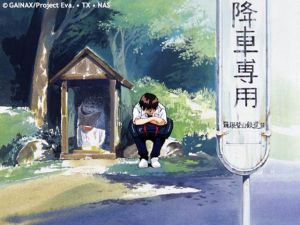
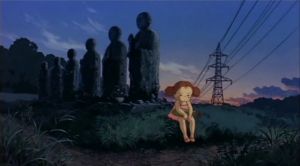
In Episode 04, after exiting the bus, Shinji rests by a statue of Jizo-san, the patron deity of travelers and children. This shot is apparently a tribute to a similar shot from Miyazaki's My Neighbor Totoro. Considering that Anno has worked as an animator on Miyazaki's Nausicaä and that he's made references to Ghibli films before Evangelion, this comparison doesn't seem too far-fetched.
Space Runaway Ideon (伝説巨神イデオン)
Space Runaway Ideon is a 1980 super robot anime by Yoshiyuki Tomino (of the Mobile Suit Gundam fame), and it is perhaps the biggest single influence on Evangelion. Its story involves a group of colonists who find a mysterious combining robot, the Ideon, on the planet Solo. While investigating the relic, another race of humanoid aliens, the Buff Clan, comes into contact with them, and a war breaks out. The protagonists escape the planet on an ancient spaceship and flee across the galaxy, using the immense power of the Ideon to fight off the relentlessly pursuing Buff Clan. As the story progresses, the characters find out that the robot seems to have a mind of its own, and that possessing the most powerful weapon in the universe is not such a great thing as it might at first seem.
The entirety of Ideon has been fansubbed by Shin Getter Fansubs; because of its age and relative obscurity, the series will almost certainly never become commercially available in the west.
- Ideon references in other works by Gainax
While the Ideon references in Evangelion are especially significant, Evangelion is not the first show by Studio Gainax to pay homage to it: many of their acclaimed works made before and after Evangelion contain more or less subtle references to Ideon, as demonstrated by the following list:
- Daicon III opening animation (1981): In this hallucinogenic short film a little girl (later to become the Daicon bunny girl) uses the Ideon's "Missile Spam" attack and blows up a lot of things (including the Ideon). Yeah, it's that messed up.
- Gunbuster (1988): During the climatic space battle scene in episode 5, the titular mecha performs Ideon's famous omni-directional missile spam attack.
- Diebuster, aka Gunbuster 2 (2004): More attack recycling from Ideon. A planetoid gets cleaved in half (after a lot of not particularly subtle foreshadowing), and a Lightning Kick attack produces a tornado-like effect, much like the Ideon Gun.
- Mahoromatic (2001): Some combat androids in Mahoromatic possess a powerful weapon in the form of energy blades extending from their hands, similar to the Ideon Swords. In episode 25, Feldrance, feeling particularly cocky, says he feels he could chop the Earth in half with his blades. Not surprisingly, slicing a planet in half is one of the Ideon's most memorable feats.
- Tengen Toppa Gurren Lagann (2007): In episode 14, the Gurren-Lagann fires a swarm of drill missiles in a very ideonish fashion.
| Ideon References in Other Works by Gainax | |
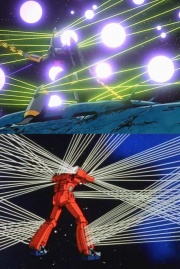 | |
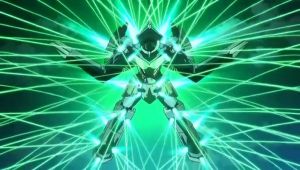 |
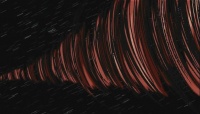 |
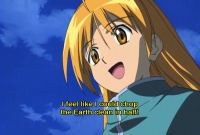 |
|
- Ideon references in Evangelion: mecha design
Although the Ideon is superficially a classic combiner super robot, the similarities with Evangelion become apparent in later episodes. The Ideon is powered by a sentient energy, known as the Ide. It is later revealed that its power is limitless and potentially capable of destroying the universe. In Evangelion, S² engines are similarly limitless sources of energy.
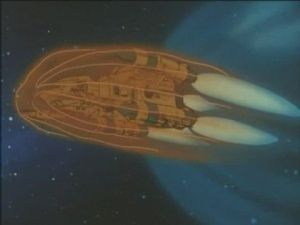
The Ide senses the emotions of the people onboard the Ideon and the Solo Ship and, for most of the time, acts to protect them. It responds more strongly to young people, becoming especially active when the baby Piper Lou is in danger - a concept similar to pilot synchronization in Evangelion. When the Ide "awakens", its offensive and defensive power increase drastically and its superweapons become usable. In extreme cases the Ideon can go berserk and act entirely independently, with devastating results. Both the Ideon and the Solo Ship can also project a protective energy barrier, the strength of which depends on the "mood" of the Ide: again, Evangelion recycled this feature in the form of A.T. Fields.
The visual cue indicating Ide's awakening is the Ide gauge lighting up and streaks of electricity flowing across the Ideon's "eye visor". In Evangelion, a similar effect indicating the Eva's resident soul taking over is a falling droplet of water, followed by the Eva's eyes lighting up.
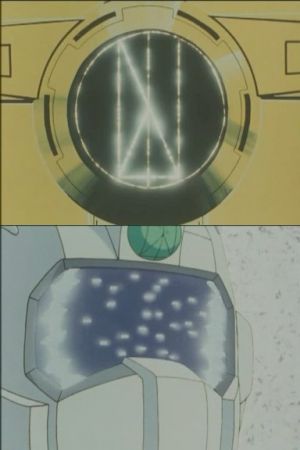
- Instrumentality in Ideon
The true nature of the Ide is explained in concrete terms in episode 34, when the sentient energy contacts Bes Jordan in a dream while he's lying ill in the Solo Ship's sickbay. The Ide describes itself as "a collection of thousands, tens of thousands, hundreds of millions of consciousnesses" - the whole population of a supposedly extinct civilization turned into a single entity of pure energy, a state very similar to the end result of Instrumentality in Evangelion.
The Ideon's berserker behavior is simply the Ide protecting itself and those it deems pure of heart. Having witnessed the warlike nature of both the humans and the Buff Clan, it now intends to pass judgement on both of the races. At the end of the dream sequence, Bes tells the Ide he's going to oppose its plans, announcing "I am not a part of you! I am me, I am myself!"; this is paralleled in Evangelion when Shinji chooses to reject Instrumentality and reaffirm his individuality.
- Religious references
Space Runaway Ideon also contains some references to religion, although they're not as overblown as in Evangelion. Buff Clan's knowledge of the Ide is based on old, distorted legends, which is why they refer to the titular robot as a "Giant God". Once its motives are starting to be revealed, the characters find themselves questioning whether the Ide really is a god or something more malevolent. Karala's baby, who appears to have the strongest connection to the Ide, is named Messiah, and true to his name, it is Messiah who at the end of the show guides the souls of the dead towards a new beginning.
- Production difficulties and Tomino Endings
Evangelion's tortured production history parallels that of Ideon to a degree that is almost scary. During its original TV run, Ideon achieved low ratings and was cancelled after 39 episodes, resulting in a incredibly rushed, ambiguous hack-job of an ending. However, due to popular demand the ending was later remade in the form of two movies. The first movie, A Contact, was a highly condensed retelling of TV episodes 1-38; the second one, Be Invoked, began with a recap of the events of episode 39 and then followed up with the originally planned final conflict between the humans and the Buff Clan, giving the story a proper conclusion.
Ideon's brutal ending is one of the biggest non-secrets of anime fandom, as most anime fans who've never even seen the show know that everybody dies in it (however, contrary to popular belief, the Ideon doesn't actually destroy the universe itself). Yoshiyuki Tomino has always had a penchant for killing his characters en masse, and Ideon is perhaps his most famous work of butchery. The violence in The End of Evangelion owes a lot to Tomino's "kill 'em all" style; a more overlooked similarity is that Be Invoked also pioneered the use of live-action footage in anime, although it wasn't used as extensively as in The End of Evangelion.
The TV ending of Evangelion also contains a major reference to Ideon. The final "Congratulations!" scene is similar to the very ending of Be Invoked, in which the souls of all the characters are flying across space and the children start singing "Happy Birthday to You" to Messiah, who's leading them towards an implied rebirth.
The Super Dimension Fortress Macross (超時空要塞マクロス)
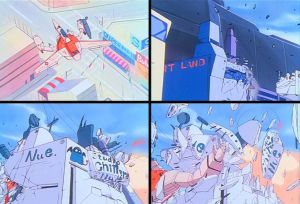
The Super Dimension Fortress Macross is a classic mecha anime that aired on October 3rd, 1982, and started a franchise of TV Series, OVAs, and Movies. It was directed by Noboru Ishiguro and featured unique mech designs that were based on the Grumman F-14 Tomcat. Hideaki Anno was a key animator on this project (see Otaku no Video).
In the first episode, the protagonist Hikaru Ichijo inadvertently ends up piloting and crash-landing a variable fighter, destroying in the process the offices of Artland and Studio Nue, the companies that created Macross. In Episode 09 of Evangelion, Asuka's Eva-02 leaps on and demolishes the half-submerged building of Studio Fantasia, one of the animation studios involved in the production of NGE.
- The genetic similarity between Humans and Zentradi
(pending)
Visual Motif: Blue Octahedrons (Nadia, Laputa and 2001)
The Fifth Angel Ramiel is shaped like a gigantic blue crystal octahedron. This shape could be a reference to a number of things:
- The Blue Water Crystal from Nadia: The Secret of Blue Water is a blue octahedron, although more elongated in shape than Ramiel.
- Hayao Miyazaki's 1986 movie Laputa: Castle in the Sky features a flying castle, which is powered by a similarly shaped blue crystal.
- Also, the "Star Gate" sequence in the movie 2001: A Space Odyssey features different kinds of psychedelic shapes and forms, including pulsating objects which momentarily look very Ramiel-like.
However, since an octahedron is not a terribly complex geometric shape, it is just as likely that all these similarities are simply unintentional coincidences. For all we know, the inspiration for Ramiel's design might have just as well come from a common salt crystal.
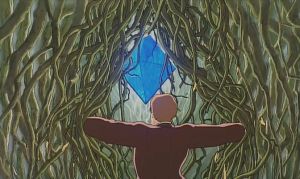

Other
2001: A Space Odyssey
Perhaps the most well-known science fiction tribute in the series, Seele's black monoliths are taken from Stanley Kubrick's classic 1968 film, 2001: A Space Odyssey.
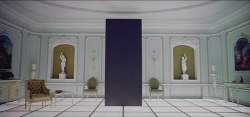
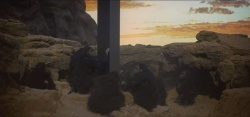
Beyond this one notable reference things get highly speculative. The following visual details have been postulated to be 2001 homages by some fans, and they are included here for completeness' sake. (See also the blue octahedron motif above.)
- The Sun, Earth and Moon in alignment
A shot that seemingly originates from 2001: A Space Odyssey and is used again in "spiritual predecessor" Ideon and once again in Evangelion, and in many other unrelated shows. However, this might as well be a case of a simple genre trope, since numerous mecha anime feature shots of the Earth from space, usually in their openings.
In Evangelion, Second Impact is prominently seen from the moon. Also, in a reversal of positions, the Sun is shown with the crescent moon under it, and Earth below, during Third Impact.
- Concentric Octagons
Aboard the spacecraft Discovery Dave Bowman walks down an octagonal corridor on his way to the Space Pods during the EVA to replace the malfunctioning AE-35 unit. The concentric octagons of an A.T. Field may have been modeled after the corridors on the Discovery.
- Lone Passenger on a Flight
Both in 2001: A Space Odyssey and in The Andromeda Strain, an important scientist is the sole passenger on a flight. Gendo is essentially the only passenger on the SSTO seen in Episode 07
- Dave's helmet and Shamshel
As a somewhat bizarre ending note, it has been pointed out that the helmet of Dave Bowman's space suit bears some resemblance to Shamshel's head.
Space: 1999
The date September 13th is a reference to this 1975 science fiction show. For more details, see Otaku no Video (the first Gainax show to make this reference).
The Andromeda Strain
(This list details some of the more notable references to Wise's 1971 movie version of The Andromeda Strain. As the movie is a very loyal adaptation of Crichton's original novel, the thematic and plotline similarities between the book and Evangelion Episode 13 are largely present in it as well and are not repeated here. Most of these findings originate from the Evangelion Mailing List FAQ (although they never had screenshots), so once solid referencing guidelines are in place, we must give credit where credit is due.)
- Interrupted call
Dr. Stone has been hauled away from his home by some "army types with guns". His wife Allison is distressed and tries to call her father who is a senator.
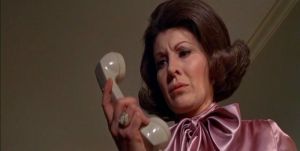
- Allison: You tell the senator it's his daughter!
- Senator: Allison?
- Allison: Dad, something very peculiar has just happened, even for Jeremy. A few minutes ago...
- (Phone begins to beep.)
- Allison: Dad, are you there? What's going on?
- Female voice: This communication is being monitored. The connection has been broken for reasons of national security. You will be briefed at the appropriate time. Thank you for your cooperation, Mrs. Stone.
In Episode 19 (Platinum subtitles):
- Kensuke: Are you there, Shinji? Is it true that you're leaving? It's true, isn't it? But why? Why are you running away now? I wanted to be like you. I envied you. You're different from us. Damn! Even Toji became an Eva pilot, while I...
- (Phone beeps.)
- Female voice: This line is monitored. For security reasons, we have terminated this call. We appreciate your cooperation.
- Flashes in the sky
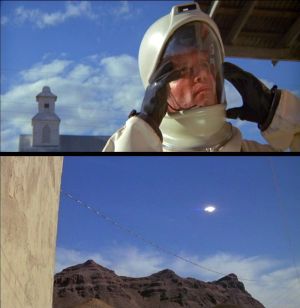
- Hall: Up there! Look.
- Stone: An Air Force jet. If we don't make it to Wildfire, he'll see the helicopter does... or shoot it down.
- Hall: Well, for Dempsey's sake, we better not slip up.
In Episode 10 (Platinum subtitles):
- Shinji: What are those?
- Ritsuko: The UN's Air Force is on standby alert.
- Ibuki: Until this mission has been completed.
- Asuka: Are they going to help us?
- Ritsuko: No, they're here to clean up.
- Ibuki: In case we fail.
- Asuka: What do you mean?
- Ritsuko: They will use N2 depth charges to destroy the Angel, and us with it.
- Asuka: That's awful!
- Open transmission
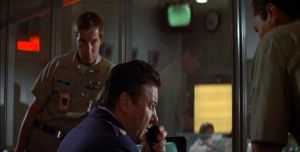
- Stone: The town is finished, contaminated beyond all...
- Major Manchek: Careful, sir. This is an open transmission.
- Stone: I'm aware of that, Manchek. Order up a 7-12.
- Major Manchek: Only the president...
- Stone: Precisely. Get on it. The town must be neutralized immediately.
In Episode 10 (Platinum subtitles):
- Misato: There's no doubt, it's an Angel. As of now, this laboratory will be completely sealed off! It's under Nerv's jurisdiction now! Any and all access to the outside world is prohibited, and all records of the events of the past six hours are classified. Request an A-17 from Commander Ikari, top priority!
- Aoba: Watch what you're saying. This is an open line.
- Misato: I know. Hurry up and switch to a scrambled line.
- Code 601
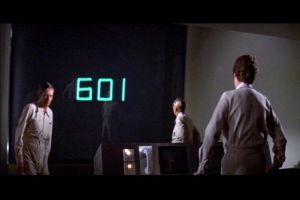
During a simulation of how the Andromeda Cell functions, an error message appears on the main computer monitor.
- Dutton: What the devil?
- Stone: 601? The computer's overloaded! Too much data coming in too fast.
In Episode 05 (Platinum subtitles):
- Misato: What the heck is this?
- Ritsuko: That's the code number for "cannot be analyzed".
- Misato: You mean, you don't know what the heck it is?
- The Shaft
Both the Wildfire facility and the geofront have a large shaft running deep below and past several levels, and the visual displays for both are very similar.
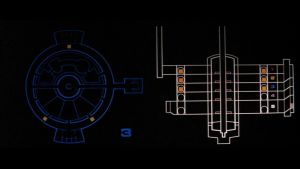
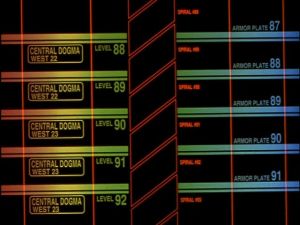
- Other visuals
As opposed to the usual octagonal, Ireul's A.T. Field projections are hexagonal in shape. Andromeda Cells, although constantly evolving, most often assume a form of a hexagonal crystal.
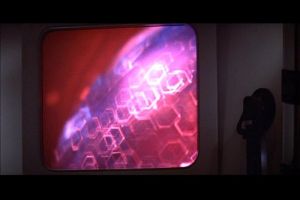
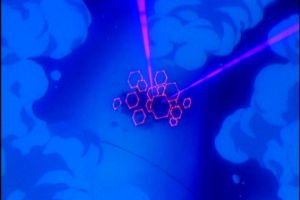
The placards in Episode 20 use the same method of counting time (black background with Nth DAY).
